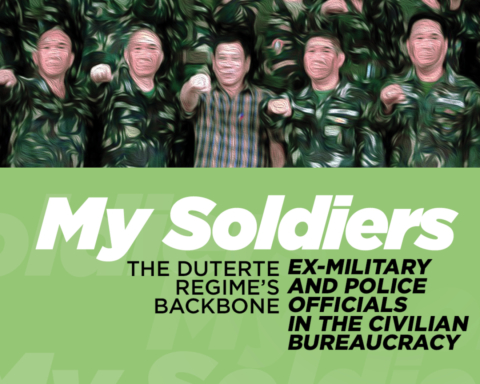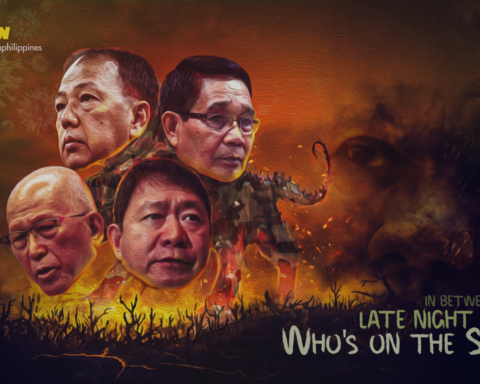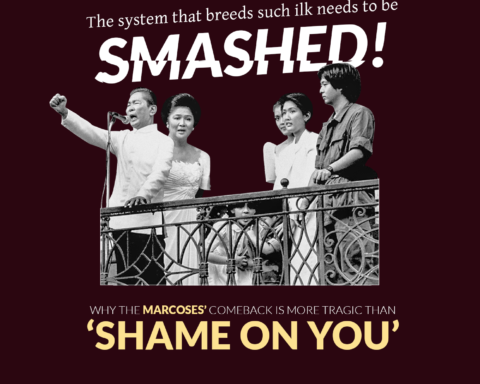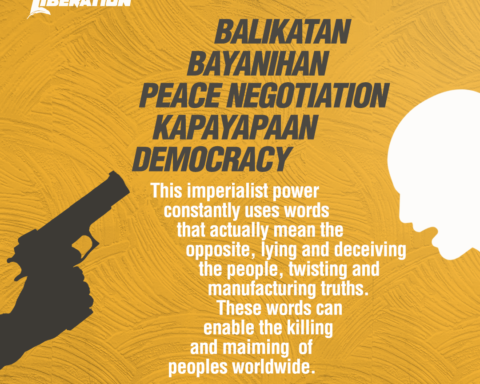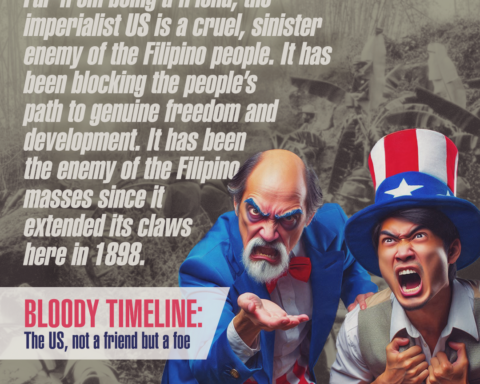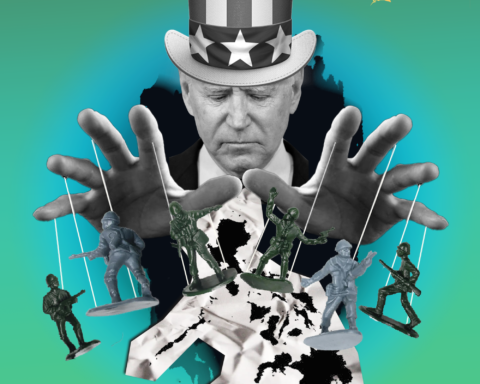by Pat Gambao
Poverty, with its attendant injustices, is the root cause of the protracted armed conflict. On this basis the National Democratic Front of the Philippines (NDFP) and the Government of the Philippines (GPH), now under the rein of Rodrigo Duterte, have engaged in peace negotiations.
But when the Duterte regime arbitrarily terminated the peace negotiations it took a complete turnaround. It now points to the armed conflict—read the Communist Party of the Philippines (CPP)-New People’s Army (NPA)-NDFP defensive armed struggle —as the cause of poverty and non-development in the country.
Indeed, it is a convenient excuse for the regime to train its guns and utilize various war resources against the revolutionary movement and the masses supporting it. Everywhere, and anywhere now, the Duterte regime sees “Red” and employs “red-tagging” to justify its clamping down against a wide range of legitimate oppositionists, critics, and ordinary civilians.
Taking off from the failed counterinsurgency program of his predecessor, Duterte took a tight grip of Benigno S. Aquino III’s “whole of nation approach” (WNA) embodied in the latter’s Oplan Bayanihan. The “whole of nation approach” readily suggests a semblance of the whole nation—the entire civilian bureaucracy, government-owned and controlled corporations, local government units, plus nongovernmental formations denoted as “other stakeholders” — mobilized against the people’s democratic revolution.
Specifically, the WNA embarked on weaponizing the civilian bureaucracy and boosted the power of the Armed Forces of the Philippines (AFP). This means blatantly placing the civilian agencies and services of the reactionary government under military centralization.
Under Duterte as strongman, a civilian-military junta, all but in name, is more apparent than ever.
From the beginning of his presidency in 2016, he has continually appointed to key positions in his cabinet and agencies retired high-ranking military and police officers. After a year, in 2017, there were already 60 former AFP and Philippine National Police (PNP) officials in the civilian bureaucracy.
To this day he continues to fill up other offices, particularly strategic ones, with ex-military officials, such as the Office of the Presidential Assistant on the Peace Process (OPAPP), the Department of Social Work and Development (DSWD, the National Commission on Indigenous Peoples (NCIP), the Metropolitan Waterworks and Sewerage System (MWSS). Recently, he appointed Gringo Honasan to head the Information and Communication Technology department, replacing another military officer Eliseo Rio, Jr. who stays as undersecretary. Duterte also named Royina Garma, Cebu’s chief of police as new head of the Philippine Charity Sweepstake Office (PCSO). There are now at least 80 former military officials in various executive offices and government-owned and controlled corporations.
In the guise of Cabinet reorganization, Duterte issued Executive Order No. 67 placing more agencies under military supervision in two departments. The EO purportedly aims to “strengthen the democratic and institutional framework of the executive department,” and eliminate “roadblocks and impediments” in pursuing the government’s agenda. Among these agencies are:
National Commission on Muslim Filipinos – transferred to the Department of Interior and Local Government (DILG)
Philippine Commission on Women – transferred to DILG
National Youth Commission – transferred to DILG
National Anti-Poverty Commission – transferred to the Department of Social Welfare and Development (DSWD)
National Commission on Indigenous Peoples – transferred to DSWD
Presidential Commission on the Urban Poor – transferred to DSWD
The move was followed by Executive Order No. 70 which created a National Task Force (NTF) to provide mechanism and structure to the WNA approach. President Duterte nominally chairs the task force with his national security adviser as vice chair. Certain cabinet members, agency heads, the AFP chief of staff, and two representatives from the private sector sit as members.
More telling, Duterte appointed the notorious retired Colonel Allen Capuyan as executive director or head of the NTF national secretariat. Capuyan’s notoriety dates back to the time of President Gloria Macapagal-Arroyo’s administration, when he headed Task Force Gantangan, which carried out a vicious “internal security plan” against the Lumad (indigenous people) of Mindanao. With his recent appointment as NCIP chairperson, Capuyan now holds two significant offices, one for “counterinsurgency”, the other to facilitate the entry of big business in IP areas such as mining and plantations. Like a number of Duterte appointees, Capuyan has been implicated in a multi-million-peso shabu trade.
More insidiously now, government services are organized into several “operational clusters” (obviously a military parlance), namely: (1)Government Empowerment Cluster; (2) International Engagements Cluster; (3) Legal Cooperation Cluster; (4) Strategic Communications Cluster; (5) Basic Services Cluster; (6) Livelihood and Poverty Alleviation Cluster; (7) Infrastructure and Resource Management Cluster; (8) AFP-PNP Peace and Development Cluster; (9) Situational Awareness and Knowledge Management Cluster; (10) Localized Peace Engagement Cluster; (11) E-Clip and Amnesty Program Cluster; and (12) Sectoral Unification, Capacity Building and Empowerment Cluster.
These clusters serve to support military operations against the revolutionary movement as well as groups and personalities perceived to be opposing Duterte.
Legal Cluster
Take the case of the Legal Cluster. Apart from the justice department, which has control over the National Bureau of Investigation (NBI) and prosecutors, the cluster consists of government security sectors such as the National Security Council (NSC), AFP/PNP, National Intelligence Coordinating Agency (NICA), Intelligence Service of the AFP (ISAFP), Intelligence Group of the PNP, the NBI, and the NCIP. The latter was thrown into the cluster apparently to watch over Lumad communities and other national minorities who are deemed prime recruits of the NPA.
With the termination of the peace talks on November 23, 2017 and Duterte’s Proclamation No.360 declaring the CPP-NPA as terrorist organizations, the legal cluster immediately set into action. The DOJ followed with a list of 656 names alleged to be “terrorist” leaders and members of the CPP-NPA including Victoria Tauli-Corpuz, UN Special Rapporteur on the rights of indigenous peoples and former chair of the UN Permanent Forum on Indigenous Issues. The list was later trimmed down to eight, but only after arrests had been made and several NDFP consultants incarcerated.
To replace Arroyo’s notoriously-vicious but inept Inter-Agency Legal Action Group (IALAG), which filed trumped-up cases against her critics based on planted evidence and false witnesses, the Duterte regime formed the Inter-Agency Committee on Legal Action (IACLA). Victims of this new body are NDFP consultants Vicente Ladlad, Rafael Baylosis, and Rey Casambre. Ladlad and Casambre are still under detention awaiting trial of their cases. Baylosis, however, has been freed after his arrest was deemed illegal, rendering the consequent case filed against him null and void.
Under IACLA, a remnant trumped-up murder case initiated by IALAG in 2006 was revived against the four progressive former legislators, dubbed by media as “Makabayan 4”: former Bayan Muna Rep. Satur Ocampo, former Bayan Muna Rep. Teddy Casino, former Gabriela Women’s Party Rep. and former National Anti-Poverty Commission Secretary Liza Maza, and former Anakpawis Rep. and former Department of Agrarian Reform Secretary Rafael Mariano. Warrants of arrest were issued against the four. However, the trial court judge found no merit in the case and summarily dismissed it.
This cluster is likewise working for the legislation of repressive laws, specifically amendments that would water down the Human Security Act (HSA).
International Cluster
The International Engagement Cluster was also set to work. Government security officials were sent “on a caravan” abroad for two objectives: 1) to counter the effective information campaign by human rights organizations critical of the Duterte government’s human rights violations — tagged by the regime as “CPP fronts”— and 2) to “cut their ties”with foreign governments, the United Nations, and international solidarity groups. The trip was an intelligence mission as well as a psyops aimed at maligning the CPP-NPA-NDFP and leaders of the progressive legal organizations. However, its main aim was to sever financial assistance coming from foreign agencies and governments to human rights defenders and legitimate NGOs branded as “communist fronts.”
Earlier, Duterte tapped the state’s own civilian agencies to do surveillance. For one, the Securities and Exchange Commission (SEC) issued in November 2018 Memorandum Circular Order 15 giving itself the authority to look into the finances of NGOs. It sought to know their sources of funds purportedly to track “money laundering to terrorist funding.” The said Memorandum likewise provides that SEC could ask the police and military to investigate the NGOs without prior notice.
Also, a news report, dated June 3, 2019, quoted Foreign Affairs Secretary Teodoro Locsin Jr. as saying in his tweet: “Over a month ago I fired off a memo to all our European embassies to tell their host governments to clear any and all donations to their NGOs in the Philippines with the DFA. Or we will deregister them in the SEC [Securities and Exchange Commission]. If that hasn’t been done do it now.” He did not provide details. His statement came after Duterte claimed that foreign governments have been supporting so-called communist fronts.
The Philippine government, through the National Task Force to End Local Communist Armed Conflict (NTF-ELCAC), has submitted to the EU and the Belgian embassy in the Philippines documents supporting claims that NGOs are used to funnel funds to the communist movement.
Immediately, international NGOs who have long supported organizations such as human rights watchdog Karapatan and Lumad school ALCADEV (two of those red-tagged organizations) countered the government’s accusation and firmly stood by their support to these organizations.
After the “international caravan” in January, the Duterte regime sent another group last June 2019 as a follow up to its lobby effort to discredit people’s organizations, specifically, human rights defenders and the Lumad in Mindanao. The Duterte government, spending millions of people’s money, sent its apologists/defenders to Belgium and New York (where they were met with protest actions) and at the recently concluded 41st session of the UN Human Rights Council UNHRC) in Geneva, Switzerland. To the regime’s chagrin, the UNHRC adopted the Iceland-initiated resolution calling on the UN High Commissioner for Human Rights, Michelle Bachelet, to make a comprehensive written report on the human rights situation in the Philippines to be discussed in the next UNHRC session.
Communications Cluster
Under the Communications Cluster, promotional work for the Duterte regime also includes demonizing the revolutionary movement as “terrorist”. Duterte’s fear of the revolution has extended to media being critical of his regime, with personalities being red-tagged, placed under surveillance, harassed, arrested or killed. In three years, 13 journalists have already been killed. The Freedom for Media, Freedom for All Network reported that from June 30, 2016 to April 30, 2019, a total of 128 cases of threats and attacks against the media have been documented. The attacks were unrelenting. From the “Red October” plot to the egregious “Oust Duterte matrix,” clearly the administration is not on a “wait and see” mode but rather on an overactive frenzy. The goal: mass intimidation. The regime is deploying all weapons in its arsenal to police even the opinions of the public: from the employment of a massive “troll army” and other forms of astroturfing or the attempt to bloat supposed public support for policies, resulting in an era where genuine reports and fake news are difficult to tell apart; the ramped-up surveillance of perceived critics of the administration; to imposing martial law in Mindanao, and similar thinly-veiled military efforts in provinces in the Visayas and Luzon.
Alternative media such as Bulatlat, Kodao, Pinoy Weekly, AlterMidya Network and others have been victims of worse cyberattacks known as DDoS (Distributed Denial of Service) where their sites have been repeatedly attacked, apparently for reasons that they have boldly criticized the regime and covered even developments in the revolutionary movement.
Also, libel and criminal cases are filed against mainstream media with threats of revoking their registrations and franchises, such as in the case of Rappler and ABS-CBN.
Basic Services Cluster
Government agencies providing basic services and programs are clustered together—the DSWD, Housing, TESDA, Education, OPAPP, NAPC— almost all under military domination.
The target of these services and programs are said to be the strongholds of the NPA. Schemes are aimed at plugging the support of the communities to the armed revolution, as well as to draw surrenderees from the people’s army. It is intertwined with the reactionary government’s programs for surrenderees, the Enhanced Comprehensive Local Integration Program (E-CLIP), and “localized peace engagement.” All of these schemes are ridden with deception and corruption.
The E-CLIP has turned out to be one of the regime’s milking cows, because millions of pesos end up in the pockets of military officials. For one, there have not been, if not a few, genuine surrenderees. Most of the so-called rebel returnees were ordinary civilians threatened, coerced and/or herded in plazas and presented to media as “surrenderees”. The Task Force Balik-Loob is said to have spent Php 520 million to Php 715 million in 2018 supposedly for the 8,000-11,000 “NPA surrenderees”—figures that are way beyond the regime’s own estimated current number of NPA members.
Sectoral Cluster
The youth, workers and urban poor groups have been identified as among the breeding grounds of the revolutionary movement. But, among the many sectors, the Lumad of Mindanao and other indigenous people’s groups have been the actual target of the sectoral unification cluster because they reside within the guerrilla fronts in Mindanao and Cordillera.
As planned, the militarized government institutions aim to lure the indigenous peoples with socio-economic programs and pretend to enhance their culture, whereas in fact they rob them of their ancestral lands for the benefit of foreign transnational corporations engaged in mining and oil palm plantation. It is small wonder that martial law was declared and extended in Mindanao where the Lumad and the Bangsamoro carry out revolutionary struggles in defense of their ancestral lands.
The age-old divide and rule tactic has always been employed by the State and is manifested through the “creation” of fake datus, initiated by the NCIP, who become conduits in the plunder of ancestral lands. The existence of AFP-backed paramilitary groups not only divides the indigenous people’s communities but has also caused countless human rights violations among those who stand their ground in defense of their ancestral lands and right to self-determination.
The NTF-ELCAC’s latest bid to subvert the Lumad’s right to self-determination was the order to close 55 Lumad schools in Southern Mindanao based on fabricated information that these schools have been teaching communist ideology to Lumad children. The Philippine government has not spent a single centavo on these schools, yet it has the gall to rob hundreds of Lumad children of their future.
In the end, weaponizing the civilian bureaucracy will only worsen the crisis within the regime and doom it to failure. On one hand corruption, patronage and inefficiency will mar the implementation of the regime’s “counterinsurgency” program as proven many times in the past; on the other hand, the regime will create more enemies than friends as it fails to silence the revolutionary movement and the broad opposition.
By now, more victims of the regime, threatened or otherwise, are joining the ranks of the revolutionary underground and the NPA. On the legal front, even organizations of different political persuasions are closing ranks and have become more emboldened in raising real-time and long-term issues against the regime.
Duterte has got it all wrong. The problem is not the CPP-NPA-NDF. It is still poverty, stupid. Duterte, like his hero Marcos, poorly understands the problems of Philippine society as their lens are clouded by their own self-interests to perpetuate themselves and their families in power.
Duterte’s ambitious and vicious reverie to crush the revolution, sustain “peace” and rule like the grand dictator will never succeed no matter how he masked his counterinsurgency program—earlier named Oplan Kapayapaan and now, a more off-key Oplan Kapanatagan— with a weaponized civil bureaucracy and deodorized by rhetoric of “development” and “humanitarian.” The convoluted reasoning, that the armed conflict is the cause of poverty, and the non-development peddled by Duterte and his armed minions to deceive and win over the people will blow on their very faces.
For as long as the root cause of the armed conflict is not addressed, for as long as the semicolonial and semifeudal state of the Philippine society stays causing abject poverty to and unfettered bondage on the masses, for as long as repression and oppression persist, all of the US-Duterte regime’s schemes are bound to fail. The revolution, which the masses look up to as their sole salvation, will continue to rage and advance to greater heights. #


